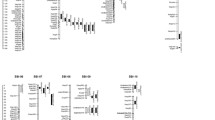Abstract
Stay green in sorghum (Sorghum bicolor L. Moench) is characterized by the plant’s ability to tolerate post-flowering drought stress, thereby delaying the premature leaf and plant death. It contributes to normal grain filling and reduces the incidence of stalk lodging and charcoal rot disease during the late stages of grain development. Breeding for improving post-flowering drought tolerance in sorghum hybrids remains an important objective of sorghum breeders. Since evaluation of the stay green response is difficult and unreliable under field conditions, due to the timing and intensity of moisture stress and large environmental interaction, progress in improving drought tolerance by conventional breeding methods has been slow. The objective of the present study was to determine the consistency of quantitative trait loci (QTLs) controlling stay green in sorghum. We re-evaluated the Recombinant Inbred Line (RIL)-mapping population from the cross B35 x Tx7000 in two locations over 2 years and compared it with earlier reports. Analysis using the combined stay green-rating means of seven environments and the expanded molecular map reconfirmed all four stay green QTLs (Stg1, Stg2, Stg3 and Stg4) that were identified earlier by Xu et al. (2000). Similarly, comparison of the stay green QTL locations with earlier reported results indicated that all four stay green QTLs showed consistency across different genetic backgrounds. Examination of the stay green QTL profiles of the best and poorest stay-green lines indicated that three stay green QTLs, Stg1, Stg2 and Stg3, appear to be important for the expression of this trait when the percent phenotypic variation, and the consistency in different backgrounds and different environments, are considered. A significant epistatic interaction involving Stg2 and a region on linkage group C was also identified for the stay green and chlorophyll content. We concluded that Stg2 is the most important QTL controlling stay green, explaining the maximum amount of phenotypic variation. This report further strengthens our view to target the Stg2 QTL region for gene discovery in order to improve the basic understanding of the stay green phenomenon, which might be helpful in manipulating this trait not only in sorghum but also in other cereal crop species.
Similar content being viewed by others
Author information
Authors and Affiliations
Additional information
Received: 12 January 2000 / Accepted: 12 February 2000
Rights and permissions
About this article
Cite this article
Subudhi, P., Rosenow, D. & Nguyen, H. Quantitative trait loci for the stay green trait in sorghum (Sorghum bicolor L. Moench): consistency across genetic backgrounds and environments. Theor Appl Genet 101, 733–741 (2000). https://doi.org/10.1007/s001220051538
Issue Date:
DOI: https://doi.org/10.1007/s001220051538




